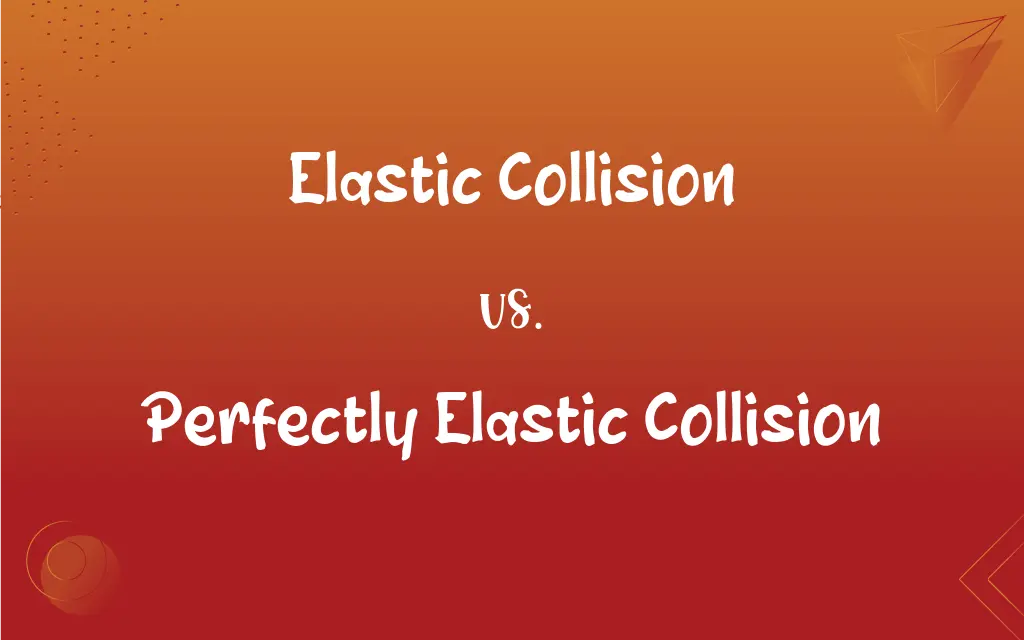Elastic Collision vs. Perfectly Elastic Collision: What's the Difference?
Edited by Aimie Carlson || By Harlon Moss || Published on February 14, 2024
An elastic collision is where total kinetic energy and momentum are conserved, while in a perfectly elastic collision, objects also rebound without any loss of energy in the form of heat or sound.

Key Differences
An elastic collision is a type of collision where the total kinetic energy is conserved before and after the collision. A perfectly elastic collision is a specific case of elastic collision where the colliding bodies completely rebound without any deformation or generation of heat.
In elastic collisions, total kinetic energy is conserved, but some energy may be transformed into other forms, like sound or heat. In perfectly elastic collisions, no kinetic energy is lost to other forms of energy; all kinetic energy is retained in the system.
Elastic collisions are common in real-world scenarios where some energy loss occurs, such as in pool or billiards. Perfectly elastic collisions are idealized scenarios, rarely observed in the real world, used more in theoretical physics.
Engineers and physicists study elastic collisions to understand real-life impacts, like car crashes. Perfectly elastic collisions are often used in physics problems to simplify calculations and understand fundamental principles.
In elastic collisions, objects may undergo some form of temporary deformation. In perfectly elastic collisions, the objects do not deform; they retain their shape and size entirely post-collision.
ADVERTISEMENT
Comparison Chart
Energy Conservation
Kinetic energy conserved, but some may transform
No kinetic energy lost
Real-world Accuracy
More common in real-world scenarios
Idealized, rare in reality
Application in Physics
Used to understand real-life impacts
Used for theoretical understanding
Object Deformation
Objects may deform temporarily
No deformation of objects occurs
Sound and Heat Generation
Possible generation of heat or sound
No heat or sound generated
ADVERTISEMENT
Elastic Collision and Perfectly Elastic Collision Definitions
Elastic Collision
A collision in which total momentum and kinetic energy remain constant.
The elastic collision between the two cars resulted in conserved momentum and energy.
Perfectly Elastic Collision
A theoretical collision scenario with total energy and momentum conservation.
In theory, a perfectly elastic collision between molecules in a gas conserves all energy and momentum.
Elastic Collision
An impact where objects rebound without permanent deformation.
During the elastic collision, the steel spheres bounced off each other without changing shape.
Perfectly Elastic Collision
A collision type used in physics to simplify calculations and understand principles.
The perfectly elastic collision model helped students learn about momentum conservation.
Elastic Collision
A collision where total kinetic energy is conserved.
In a game of pool, the elastic collision of the balls conserves kinetic energy.
Perfectly Elastic Collision
A collision with no loss of kinetic energy and no deformation.
In a perfectly elastic collision, the colliding particles rebounded without losing speed.
Elastic Collision
A physical event where energy transformation occurs without total kinetic energy loss.
In an elastic collision, the bouncing ball lost some energy to sound but retained most of its kinetic energy.
Perfectly Elastic Collision
An interaction in physics where colliding bodies do not lose energy to heat or sound.
During the perfectly elastic collision experiment, there was no noticeable sound or heat produced.
Elastic Collision
An interaction where colliding bodies may generate sound or heat.
The elastic collision of the hammer with the bell produced a loud ring.
Perfectly Elastic Collision
An idealized impact where objects completely conserve kinetic energy.
The perfectly elastic collision in the physics simulation showed no energy loss.
FAQs
What is a perfectly elastic collision?
A perfectly elastic collision is an idealized collision where no kinetic energy is lost and objects rebound without deformation.
How is momentum conserved in an elastic collision?
In an elastic collision, the total momentum of the system remains constant before and after the collision.
Are elastic collisions common in daily life?
Yes, elastic collisions, such as those in sports like billiards, are quite common.
Does a perfectly elastic collision conserve momentum?
Yes, like elastic collisions, perfectly elastic collisions also conserve total momentum.
Is there any energy transformation in a perfectly elastic collision?
No, in perfectly elastic collisions, kinetic energy is not transformed into other forms of energy.
Do objects deform in a perfectly elastic collision?
No, objects do not deform in a perfectly elastic collision.
What defines an elastic collision?
An elastic collision is one where total kinetic energy is conserved during the collision.
Is a perfectly elastic collision practical in real scenarios?
No, perfectly elastic collisions are mostly theoretical and rare in real-life situations.
Can kinetic energy be transformed in an elastic collision?
Yes, in elastic collisions, some kinetic energy may transform into heat or sound.
Can elastic collisions produce sound?
Yes, elastic collisions can produce sound, like a clack in billiards.
How do elastic collisions apply to vehicle safety design?
Understanding elastic collisions helps design vehicles that better manage impact forces.
Can we observe perfectly elastic collisions in sports?
No, perfectly elastic collisions are not observed in sports due to energy losses.
Do perfectly elastic collisions produce sound?
No, perfectly elastic collisions do not typically produce sound.
Can temperature affect elastic collisions?
Yes, temperature can affect the elasticity of colliding objects, thus impacting the collision nature.
Do objects deform in an elastic collision?
Objects may undergo temporary deformation in an elastic collision.
How important are elastic collisions in physics?
Elastic collisions are fundamental for understanding momentum and energy conservation in physics.
Is the concept of a perfectly elastic collision important?
Yes, it is important theoretically to understand the limits of energy conservation.
Does temperature affect perfectly elastic collisions?
In theory, temperature should not affect perfectly elastic collisions as they are idealized scenarios.
Are perfectly elastic collisions used in vehicle design?
No, because they are idealized scenarios and not practical for real-world designs.
What is an example of an elastic collision in sports?
The impact of hockey pucks during a game is an example of an elastic collision.
About Author
Written by
Harlon MossHarlon is a seasoned quality moderator and accomplished content writer for Difference Wiki. An alumnus of the prestigious University of California, he earned his degree in Computer Science. Leveraging his academic background, Harlon brings a meticulous and informed perspective to his work, ensuring content accuracy and excellence.
Edited by
Aimie CarlsonAimie Carlson, holding a master's degree in English literature, is a fervent English language enthusiast. She lends her writing talents to Difference Wiki, a prominent website that specializes in comparisons, offering readers insightful analyses that both captivate and inform.
































































